

Ivo's four-engine enigma
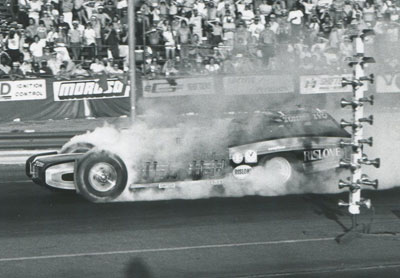 |
Ask any 500 Tommy Ivo fans which of his many, many race cars is his most famous, and it’s a pretty safe bet that 495 of them will say it’s his wild four-engine Showboat. And who could blame them? With four Buick engines snorting at once and driving all four wheels, it was an unforgettable sight.
But, in the truth-is-stranger-than-fiction department, “TV Tommy” actually only got to drive his signature car about a dozen times two decades apart.
The legions of fans who tell their grandchildren about seeing Ivo drive the car more than likely saw either Ron Pellegrini (1960s) or Rick Johnson (1980s) behind the wheel of the smoke-churning beast when it did its thing at dragstrips far and wide across the country.
It’s a curious lament that Ivo must sing whenever he talks about the car, but it's one that he has accepted over time and one about which both he and Pellegrini were happy to share the details with me. Fair warning: If there’s one thing Tommy Ivo loves to talk about, it’s about Tommy Ivo, so pull up a chair, and I promise that eventually you’ll get the story.
The pre-story begins in 1960, the year before the Showboat first turned four tires on the track. As I shared here in a previous column, that was the year that Ivo took his first tour of the country with his side-by-side twin-Buick-engine dragster and an eager young crewman named Don Prudhomme in tow.
Knowing that Ivo would be far from his Southern California base, Pellegrini offered his Chicago-area speed shop (Speed Craft, located in Maywood, Ill.) as a base and a haven, and Ivo gratefully accepted. Ivo had never met Pellegrini or seen him before and was in for a surprise when he did.
“We walked through the door of his shop and there stood Herman Munster!” Ivo recalled. “Pellegrini is the only guy in the world with a ‘longer’ face than Fred Gwynne. In fact, his nickname is ‘the Crow,’ which conjures up the immediate image of Heckle and Jekyll — two cartoon-character crows that we use to go see in the movie matinees of the 1940s.
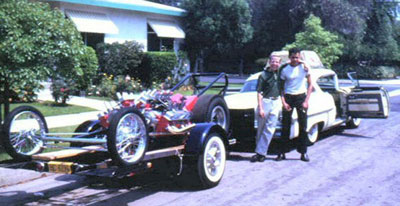
Ivo and Prudhomme ready to head out with the twin for the 1960 tour.
|
“His shop consisted of a small front counter sales room and a decent-sized shop in the rear where they outfitted getaway cars for the Cicero thugs of the era. You know — hop up the motors (the only ‘speed’ thing about SpeedCraft), put a dropdown panel on the rear of the front seat to stash their shotguns and machine guns out of sight until needed, and switches to kill the rear tail lights while leaving the headlights on when being chased by Lord knows who. That was pretty high tech for the day. Yee Gods, I expected to see Efrem Zimbalist Jr. and the FBI walk in the front door and carry us all off to the slumber at any moment … but, as luck would have it, ‘working on the car’ at Pellegrini's was one of the highlights of the tour, and he ended up being one of my dearest friends over the years to come. Yes, I'm a glutton for punishment!!!"
Ivo air-quoted “working on the car” because, other than cleaning up the car between weekends, they didn’t have to actually do a lot of work on the car, as it seldom broke.
“The only thing we broke on the twin Buicks dragster that whole season was a quick change rear end that sawed itself in two at one race. That could've been disastrous if the rear end wasn't offset to one side to line up with the clutch on the left-side engine," recalled Ivo, who walked away with just a bruise on his hip.
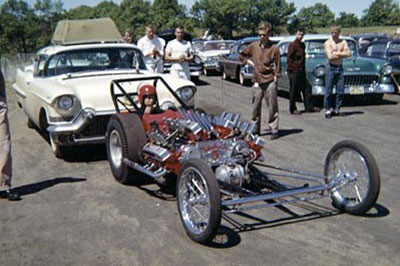 |
“Well, we also did ‘break’ the 180-mph barrier on gasoline at two different tracks as well,” he said, enjoying the pun. “We had already been the first to run 170 mph on the West Coast, but that was in the sandlot days, and if we had to do any heavy engine work, it was not a between-rounds fix in 45 minutes like nowadays. It took six men and a small boy to get the motors out of the car as a package of two and then split them, and I didn't even see a chain hoist in Pellegrini's place strong enough to do that.”
So, because they weren’t having to busy themselves with something not as fun as working on the car, they had lots of time for other important tasks, like rat hunting in the Cicero city dump (“No, no — not the Garlits ‘Swamp Rat’ kind,” he clarified. “Real rats, with long tails … although they both have beady little eyes, especially when I did something ‘Swampie’ didn't like — which was most of the time.” < Ivo-type grin>).
According to Ivo, Pellegrini had an in with the Cicero cops, so they’d feel pretty sure they’d stay on the right side of the law when they headed out to the dump with sawed-off shot guns and Tommy guns, with spotlights duct-taped to the guns, to blast the rodents, who were drawn by the waste dumped by the Campbell Soup company (“That was better to the rats than the hot dog stand to a starving drag racer,” Ivo noted).
Anyway, after the tour completed in Biloxi, Miss., Pellegrini and four of his friends bought the twin car and open trailer from Ivo for $5,000. Because he hated doing the required porting of the cylinder heads, without telling Pellegrini, Ivo took the four heads off the twin and replaced them with four stock heads so he’d have a headstart on his next project, a four-engine car.
![]()
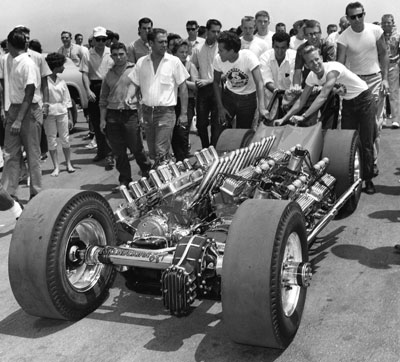
Prudhomme, Ivo, and the Showboat
|
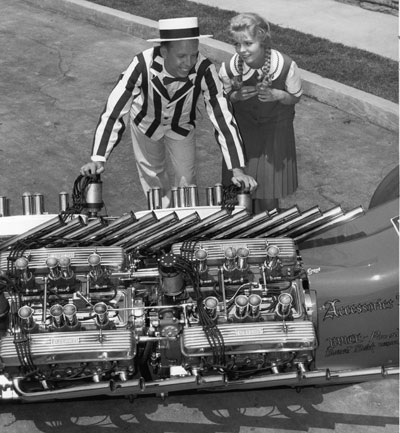 |
“I had already figured out that there was money to be made in drag race touring, and if the fans liked two motors, they'd love four,” Ivo reasoned.
Ivo had the four-engine car built in his two-car garage in Burbank, Calif., for about $4,000. Master chassis builder Kent Fuller did the framework for $15 an hour, Buick supplied the four engines, each with a displacement of 464 cubic inches (1,856 total), and a host of suppliers (led by Iskenderian and Weiand) gave him free parts. Ivo estimates that the car would cost about $250,000 to build today. Industrial chain couplers were used to tie each pair of engines together. The engines on the left side of the car faced backwards and powered the front differentiaL — which featured a reverse ring gear, originally engineered for the four-wheel-drive Novi Indycars, to make it run 'backwards” — and the right-side engines powered the rear differential. It weighed more than a ton and a half.
Before he even got a chance to drive the car, Ivo was hired for the male lead role as “the 10-thumbed bumbling” Haywood Botts in the television series Margie for 1961 and 1962, and the studio bosses were not keen on their star climbing into such a contraption, nor even had they given their blessing did his schedule allow him to be both television star and a “dashing, handsome touring race car driver,” as he called it. “I somehow always knew I should stay away from that 3,500-pound four-engine Sherman tank,” he says. “It was an omen I think.”
So he hired his crewman, Prudhomme, giving him his first starring role (or, possibly, as Ivo sometimes tells it, a chance to be his “test pilot” in the wild, new machine).
Prudhomme drove the car locally but only pocketed $25 (plus expenses) of the car’s $500 booking fee. Ivo promised a steady income if Prudhomme took the car on tour, but, according to Ivo, Prudhomme’s then-girlfriend (and soon-to-be wife) Lynn “put the kibosh” on him heading east for another summer tour. Mutual friend Tom McCourry, who had been helping on the car, was then offered the seat. “I had the distinction to be the first one to fire Prudhomme!” Ivo noted, with a “happy Ivo-type grin” thrown in.
Ivo got his first — and for 20 years, his only — ride in the car at the old San Gabriel track because of an oversight: They forgot to put the seatbelts into the car.
“We sent a faithful dog on a run back to the shop to get them, but we had to make the first run without them,” he said. “McCourry's back grew a big yellow streak down it, and he didn't want to hear any of it. So that became my first ride in the car. They tied me in the car with ropes to make the run. Nice! And that was really my one and only ride until I got it back again in 1982 to run it for my 30th anniversary and last match race tour.”
![]()

Pellegrini, second from right next to Ivo — you can see the height difference that Pellegrini mentions — as he took possession of the Showboat.
|

You could say that Pellegrini stayed in a lot of motels along the way.
|
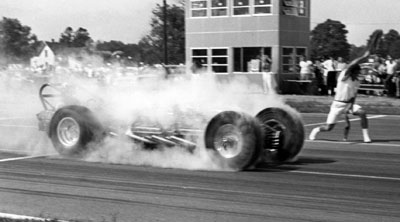
Pellegrini made exhibition runs at the 1961 Nationals in Indy.
|
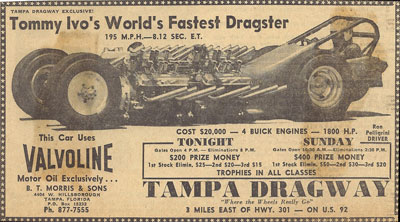 |
After McCourry, Pellegrini was offered the ride and says he flew out to California to pick up the car. (Ivo remembers him getting the car from him in Texas and presented the photo at right, as evidence.)
Pellegrini is sticking by his version: “I remember talking to Don when I came to get the car and how disappointed he was that he was not going on tour,” he maintains, “but that turned out to be the best thing for him as he ended up with the Greer-Black-Prudhomme ride and his accession to his fame.
“I took the car directly to Minnesota Dragway, never having driven the car, for a booked-in appearance. Because I was taller than Tom, my head stuck out above the rollbar, and I had to drive the car with no shoes as I could not get my size 12s on the pedals. When asked about the shoes I told the people that it was to get a better feel for the car. The 1961 tour was an eye opener for me as there was no format to follow. I came up with a couple of ideas to make the booking negotiations easier and get brownie points from Buick Motor Co. I would put the car on display at a local Buick dealer, and, in exchange, they would advertise that the car was on display at their show room and appearing at the race track that weekend.
“The car was great to tour with as it was almost maintenance free. All that was necessary was to change the oil and plugs and adjust the valves. Even though it was powered by four fire-breathing Buicks, it was not competitive due to its weight and drivetrain configuration. The car was a dream to drive, but due to weight transfer, it would not smoke the rear tires. Tom talked about connecting all four motors together but never followed up on it as he started fuel racing. Who knows what would have happened if all four motors were connected together?”
(Pellegrini got a chance to get even with Ivo — as Ivo sees it — for the cylinder-head swap on the twin. Pellegrini had Ivo’s gasoline credit card to fill the tow rig. “And he'd fill the tow car gas tank up, as well as all his buddy's tanks, with a cash kickback from them, every weekend,” Ivo reports. “I had so much going on at the time, I really wasn't scrutinizing my credit cards all that well, and Ron figured this out right away when I didn't ask how he put 60 gallons for gas in the tow car. Oh, I'm sure he'd have told me it was for both the dragster and the tow car. Yeah, right!!! The four-engine car used one gallon of gas a run — and the other 37 gallons went where? Hmmmmmmmmmmmmm!!!”)
Pellegrini ran the car for the 1961, '62, and '63 seasons, running at least once a week. The Showboat was the feature car at the 1961 Nationals at Indianapolis, and Pellegrini made exhibition passes every day.
“The car was booked solid, and all I had to do was make three tire-smoking runs to fulfill the contracts,” said Pellegrini. “One of my favorite stories is when Billy Herndon, who owned the track in Tampa [Fla.], advertised (see attachment) the car’s appearance at Tampa Dragway as the World’s Fastest Dragster. You can guess who resides in the Tampa area and took offense at the proclaimed title of World's Fastest. Garlits appeared that night at the track with his trusty black steed to lay down the challenge. Try as he might, we were never able to line up at the same time, but that's another story open for interpretation. Still, in its various incarnations, it was undoubtedly one of the drag racing world's most popular and enduring cars.”
Promoters were forever asking Pellegrini to match race the car against other competition, but he knew that the car just wasn’t built for speed and perhaps was losing some of its popularity; Ivo agreed and sold the car after the 1963 season to McCourry, who ran the car (and later had Tom Hanna make a Buick station wagon body for the car, renamed the Wagon Master) for the next five years before selling it to Norm Day.
![]()

Ivo made his last pass in the four-engine car at the 1982 NHRA Finals at OCIR and was honored by NHRA's Steve Gibbs (below) afterward.
|
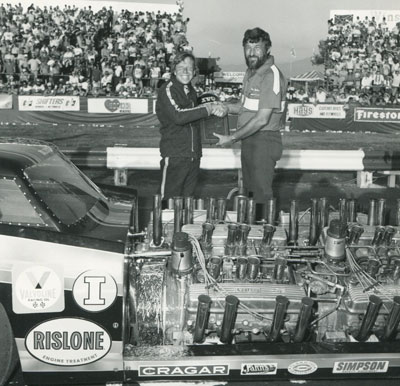 |

Ivo and Pellegrini (and RP's ponytail) today; still pals.
|
Ivo did get the car back — complete with the station wagon body — for what he hoped would be an around-the-country farewell tour, complete with his famous glass-sided trailer, in 1982. He didn’t get very far. At his third stop, and after just a dozen passes, he crushed three vertebrae in his back after running over a frost heave under the track in Saskatoon, Sask. Funny Car driver Rick Johnson drove the car the rest of the year.
Not content to go out with a whimper, Ivo climbed back into the car at the 1982 World Finals at Orange County Int’l Raceway, stuffed about a dozen pillows into the cockpit to cushion him, and made his final pass. He drove the car back to the starting line, jumped on top of the car, took a pair of BBQ tongs and set alight his driving gloves with one of the portable propane track driers. “They all say they ‘burned their gloves.' I wanted to go out with some dramatic flair,” he explained. “Problem is I took a brand-new pair of driving gloves and burned them up. No one ever called me the sharpest knife in the drawer.”
Although he seldom drove it and his driving career ended with a huge bump in the road, he’s still glad he built the iconic machine.
“Had I have never built that four-engine car, I may not have ever stood the test of time to be remembered today,” he reasons. “I was dumbfounded when my book came out in 2012, and it sold like hotcakes. We went into a second printing in the second month out. I thought we'd sell 10 of them and get eight of them back. And I am completely convinced that the dreaded four-engine car had a heavy hand in making that happen.
“Both Ron Pellegrini and Tom McCourry were excellent representatives for me, and many people think to this day it was me that they saw driving it in all the early years. Only when Pellegrini told me the car was done in popularity after his two years of touring it back east did I sell it to McCourry, who it ran two more years as a dragster and several years after that. (Don't take any tips from Ron on the stock market!!!)
“And the half-full glass for me in this whole thing is that with the gypsy in my soul that made the bottom of my feet itch every six months, and I had to go somewhere, and [not continuing to drive the car] gave me the time to barnstorm the world, from one corner of the globe to the other, for all these years after my forced retirement from drag racing.
“Only people that have the good fortune to find an Aladdin's Lamp get three wishes. The movies, racing, and traveling the world. There's sure more than one way to skin a cat, but when it comes to what you get to do with your life, I found one of them!”
Major thanks to both Tommy and Ron for sharing their great memories of one of the sport's most spectacular cars; I hope you enjoyed their tales.
This will be the final regular Dragster Insider column of 2013. The NHRA offices are closed beginning today (Dec. 20) through Jan. 2. I had planned to write a season column recap column that would auto-post Dec. 27 but that was before I broke my leg playing hockey earlier this week that put me out of action. It's also highly unlikely that I'll be able to put together a column quickly for Jan. 3, but who knows? The muse may strike me. You'll just have to check back. If not, well, it's going to be a longer wait for you guys; sorry 'bout that.



















































